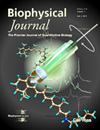单细胞动态流变反应的转变:从流体样到固体样。
IF 3.1
3区 生物学
Q2 BIOPHYSICS
引用次数: 0
摘要
细胞的力学性质对阐明各种生理和病理过程至关重要。发现细胞在低频时表现出普遍的幂律流变行为。虽然它们在高频状态下的行为方式不同,这使得过渡区域在很大程度上未被探索。在这里,我们通过原子力显微镜(AFM)-微流变学方法研究了不同细胞类型(原代造血干细胞、海马神经元细胞系和人牙髓干细胞)的单细胞流变学行为,揭示了一种普遍的两阶段幂律流变行为。细胞在较短的时间尺度上表现为液体状,在较长的时间尺度上表现为固体状。为了描述这些阶段之间的过渡区域,我们引入了一个时间尺度参数,称为“过渡时间”。值得注意的是,对于所研究的所有细胞类型,我们发现过渡时间随着弹性模量的增加而减少,并且随着幂律指数的增加而增加。在此基础上,提出了一种确定过渡时间范围上下界的理论方法。我们的实验结果表现出极好的一致性,始终落在预测的理论范围内。此外,我们提出了六个关键的力学指标来描述单细胞的动态和静态力学性能。这些参数可以有效地区分细胞类型,并提供细胞力学状态的全面视角。我们的研究可能为细胞从流体样行为到固体样行为的粘弹性转变提供新的见解,并突出了生物力学过程中不同时间尺度的机制。本文章由计算机程序翻译,如有差异,请以英文原文为准。
A transition of dynamic rheological responses of single cells: from fluid-like to solid-like.
The mechanical properties of cells are crucial for elucidating various physiological and pathological processes. Cells are found to exhibit a universal power-law rheological behavior at low frequencies. While they behave in a different manner at high frequency regimes, which leaves the transition region largely unexplored. Here, we investigate single-cell rheological behaviors across different cell types (primary hematopoietic stem cells, the hippocampal neuronal cell line and human dental pulp stem cells) by atomic force microscopy (AFM)-microrheology method, uncovering a universal two-stage power-law rheological behavior. Cells behave fluid-like at shorter time scales and solid-like at longer scales. To characterize the transition region between these stages, we introduce a time-scale parameter, termed "transition time". Notably, for all the cell types under study, we find that the transition time decreases with increasing elastic moduli and increases for larger power-law exponent. Furthermore, based on our previous self-similar hierarchical model, we propose a theoretical method to determine the upper and lower bounds of the transition time range. Our experimental results exhibit an excellent agreement, consistently falling within the predicted theoretical limits. Furthermore, we present six crucial mechanical indices that depict both the dynamic and static mechanical properties of single cells. These parameters can effectively differentiate cell types and provide a comprehensive perspective on the mechanical states of cells. Our study may offer new insights into the viscoelastic transformation of cells from fluid-like to solid-like behaviors, and highlights the mechanisms underlying various time scales during biomechanical processes.
求助全文
通过发布文献求助,成功后即可免费获取论文全文。
去求助
来源期刊

Biophysical journal
生物-生物物理
CiteScore
6.10
自引率
5.90%
发文量
3090
审稿时长
2 months
期刊介绍:
BJ publishes original articles, letters, and perspectives on important problems in modern biophysics. The papers should be written so as to be of interest to a broad community of biophysicists. BJ welcomes experimental studies that employ quantitative physical approaches for the study of biological systems, including or spanning scales from molecule to whole organism. Experimental studies of a purely descriptive or phenomenological nature, with no theoretical or mechanistic underpinning, are not appropriate for publication in BJ. Theoretical studies should offer new insights into the understanding ofexperimental results or suggest new experimentally testable hypotheses. Articles reporting significant methodological or technological advances, which have potential to open new areas of biophysical investigation, are also suitable for publication in BJ. Papers describing improvements in accuracy or speed of existing methods or extra detail within methods described previously are not suitable for BJ.
 求助内容:
求助内容: 应助结果提醒方式:
应助结果提醒方式:


